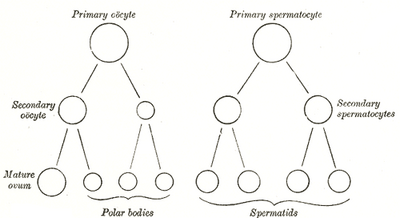No edit summary |
No edit summary |
||
| Line 1: | Line 1: | ||
{{BioPsy}} |
{{BioPsy}} |
||
| − | '''Gametogenesis''' is a [[biology|biological]] process by which [[diploid]] or [[haploid]] [[precursor cell]]s undergo [[cell division]] and differentiation to form mature haploid [[gamete]]s. Depending on the [[biological life cycle]] of the [[organism]], gametogenesis occurs by [[meiosis|meiotic]] division of diploid [[gametocyte]]s into various gametes, or by [[mitosis|mitotic]] division of haploid gametogenous cells. The gametophytes grow from haploid spores after sporic meiosis. |
+ | '''Gametogenesis''' is a [[biology|biological]] process by which [[diploid]] or [[haploid]] [[precursor cell]]s undergo [[cell division]] and differentiation to form mature haploid [[gamete]]s. Depending on the [[biological life cycle]] of the [[organism]], gametogenesis occurs by [[meiosis|meiotic]] division of diploid [[gametocyte]]s into various gametes, or by [[mitosis|mitotic]] division of haploid gametogenous cells. The gametophytes grow from haploid spores after sporic meiosis. |
==In animals== |
==In animals== |
||
| Line 32: | Line 32: | ||
|} |
|} |
||
| − | ==In gametangia== |
||
| − | Fungi, algae and primitive plants form specialized haploid structures called [[gametangium|gametangia]] where gametes are produced through mitosis. In some fungi, for example [[zygomycota]], the gametangia are single cells on the end of [[hypha]]e and acting as gametes by fusing into a [[zygote]]. More typically, gametangia are multicellular structures that differentiate into male and female organs: |
||
| − | * '''[[antheridium]]''' (male) |
||
| − | * '''[[archegonium]]''' (female) |
||
| − | |||
| − | ==In flowering plants== |
||
| − | In flowering plants, the male gamete is produced inside the [[pollen|pollen grain]] through the division of a generative cell into two sperm nuclei. Depending on the species, this can occur while the pollen forms in the [[anther]] or after [[pollination]] and growth of the [[pollen tube]]. The female gamete is produced inside the [[embryo sac]] of the [[ovule]]. |
||
==See also== |
==See also== |
||
Latest revision as of 22:03, 5 October 2011
Assessment |
Biopsychology |
Comparative |
Cognitive |
Developmental |
Language |
Individual differences |
Personality |
Philosophy |
Social |
Methods |
Statistics |
Clinical |
Educational |
Industrial |
Professional items |
World psychology |
Biological: Behavioural genetics · Evolutionary psychology · Neuroanatomy · Neurochemistry · Neuroendocrinology · Neuroscience · Psychoneuroimmunology · Physiological Psychology · Psychopharmacology (Index, Outline)
Gametogenesis is a biological process by which diploid or haploid precursor cells undergo cell division and differentiation to form mature haploid gametes. Depending on the biological life cycle of the organism, gametogenesis occurs by meiotic division of diploid gametocytes into various gametes, or by mitotic division of haploid gametogenous cells. The gametophytes grow from haploid spores after sporic meiosis.
In animals

Scheme showing analogies in the process of maturation of the ovum and the development of the spermatids, following their individual pathways. The oocytes and spermatocytes are both gametocytes. Ova and spermatids are complete gametes. In reality, the first polar body typically dies without dividing.
Animals produce gametes directly through meiosis in organs called gonads. Males and females of a species that reproduces sexually have different forms of gametogenesis:
- spermatogenesis (male)
- oogenesis (female)
Stages
However, before turning into gametogonia, the embryonic development of gametes is the same in males and females.
Common path
Gametogonia are usually seen as the initial stage of gametogenesis. However, gametogonia are themselves successors of primordial germ cells. During early embryonic development, primordial germ cells (PGCs) from the dorsal endoderm of the yolk sac migrate along the hindgut to the gonadal ridge. They multiply by mitosis and once they have reached the gonadal ridge in the late embryonic stage, they are called gametogonia. Gametogonia are no longer the same between males and females.
Individual path
From gametogonia, male and female gametes develop differently - males by spermatogenesis and females by oogenesis. However, by convention, the following pattern is common for both:
| Cell type | ploidy/chromosomes | chromatids | Process |
| gametogonium | diploid/46 | 2N before replication, 4N after it | gametocytogenesis (mitosis) |
| primary gametocyte | diploid/46 | 2N before replication, 4N after it | gametidogenesis (meiosis 1) |
| secondary gametocyte | haploid/23 | 2N | gametidogenesis (meiosis 2) |
| gametid | haploid/23 | 1N | |
| gamete | haploid/23 | 1N |
See also
- Microgametogenesis
Physiology, endocrinology, sex: Reproductive physiology and endocrinology | |
|---|---|
| Menstrual cycle/Estrous cycle | |
| Gametogenesis |
Spermatogenesis -Oogenesis |
| Sexuality |
Human sexual behavior - Sexual intercourse - Erection - Ejaculation - Orgasm - Insemination - Fertilisation/Fertility - Masturbation - Pregnancy - Postpartum period |
| Lifespan |
Prenatal development - Sexual dimorphism - Sexual differentiation - Puberty (Menarche, Adrenarche) - Maternal age/Paternal age - Climacteric (Menopause, Andropause) |
| Eggs |
Oviposition - Oviparity - Ovoviviparity - Viviparity |
| This page uses Creative Commons Licensed content from Wikipedia (view authors). |